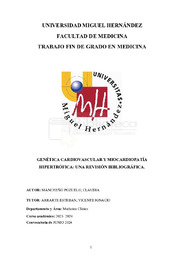Por favor, use este identificador para citar o enlazar este ítem:
https://hdl.handle.net/11000/34070Genética cardiovascular y miocardiopatía hipertrófica: un revisión bibliográfica
| Título : Genética cardiovascular y miocardiopatía hipertrófica: un revisión bibliográfica |
| Autor : Mancheño Pozuelo, Claudia |
| Tutor: Arrarte Esteban, Vicente Ignacio |
| Editor : Universidad Miguel Hernández |
| Departamento: Departamentos de la UMH::Medicina Clínica |
| Fecha de publicación: 2024-05-11 |
| URI : https://hdl.handle.net/11000/34070 |
| Resumen : Introducción. La miocardiopatía hipertrófica (MCH) primaria es la enfermedad cardíaca de origen genético más frecuente (1/500) y su diagnóstico se establece por exclusión de causas secundarias de hipertrofia ventricular. Se caracteriza por una penetrancia incompleta y una expresividad heterogénea. Hasta en un 60% de los casos, las mutaciones afectan a genes que codifican proteínas sarcoméricas, siendo MYBPC3 y MYH7 los más frecuentemente detectados. El genotipo sugiere tener implicación a nivel fenotípico y pronóstico en relación con la estratificación del riesgo de morbimortalidad, hipótesis en el que se basa la elaboración del presente trabajo. Objetivo. Valorar la capacidad pronóstica del estudio genético en el manejo clínico de la MCH del adulto. Metodología. Se realizó una revisión bibliográfica de la evidencia actual acerca de la relación genotipo-fenotipo en la MCH, así como de la estratificación pronóstica asociada, con resultados principalmente seleccionados de la base de datos MEDLINE, a través del buscador PubMed y de los siguientes términos MeSH: “hypertrophic cardiomyopathy”, “genetics”, “genotype” y “prognosis”. Tras aplicación de filtros y lectura de títulos y resúmenes, se recogió un total de 16 publicaciones. Como literatura complementaria, se recurrió a UpToDate, guías clínicas de las sociedades científicas europea (ESC 2023) y americana (AHA/ACC 2020), así como libros de texto. Resultados. Fueron seleccionados 8 estudios analíticos observacionales de tipo cohortes. En la mayoría, se obtuvieron resultados positivos para la existencia de una correlación genotipo- fenotipo característica, así como un riesgo incrementado estadísticamente significativo de morbimortalidad global y específica, en las cohortes de pacientes con variantes sarcoméricas patogénicas o probablemente patogénicas (P/LP). Discusión. Comparando nuestros resultados con los de 4 metaanálisis de reciente publicación, se observó que existe disonancia a la hora de evaluar el papel de las mutaciones sarcoméricas como predictor de mortalidad. En efecto, en el metaanálisis de Christian et al.17, no se contemplaron resultados estadísticamente significativos en cuanto al aumento del riesgo de mortalidad por cualquier causa, muerte súbita de origen cardíaco (MSC) o insuficiencia cardíaca (IC) grave. Conclusiones. Con la literatura revisada, podemos concluir que, a pesar de existir hallazgos discordantes en relación con el objetivo principal, la mayoría de los resultados respaldan el aumento de la morbimortalidad cardiovascular global en pacientes con MCH portadores de mutaciones sarcoméricas; teniendo en cuenta otras variables pronósticas no genéticas que influyen en la estratificación del riesgo de la enfermedad. Con todo, son necesarios estudios aleatorizados y con seguimiento a largo plazo para mejor el nivel de evidencia científica actual en este campo. Background. Primary hypertrophic cardiomyopathy (HCM) is the most common genetic heart disease (1/500), and its diagnosis is established by exclusion of secondary causes of ventricular hypertrophy. It is characterized by incomplete penetrance and heterogeneous expressivity. In up to 60% of cases, mutations affect genes encoding sarcomeric proteins, with MYBPC3 and MYH7 being the most frequently detected. The genotype suggests to have implications in the phenotypic expression and in prognosis, in relation to the stratification of the risk of morbidity and mortality, a hypothesis on which this work is based. Objective. The goal of this study was to assess the prognostic capacity of genetic study in the clinical management of HCM in adults. Methods. A literature review of the current evidence on genotype-phenotype relationship in HCM, as well as the associated prognostic stratification, was carried out with results mainly selected from the MEDLINE database, through the PubMed searcher and using the following MeSH terms: “hypertrophic cardiomyopathy”, “genetics”, “genotype” and “prognosis”. After applying filters and reading titles and abstracts, a total of 16 publications were collected. As complementary literature, we used the platform UpToDate, clinical guidelines of the European (ESC 2020) and American (AHA/ACC 2020) scientific societies, as well as textbooks. Results. A total of 8 analytical and observational cohort studies were selected. In most cases, positive results were obtained for the existence of a characteristic genotype-phenotype correlation, as well as a statistically significant increased risk of global and specific morbidity and mortality in the cohorts of patients with pathogenic or probably pathogenic sarcomeric variants (P/LP). Discussion. Comparing our results with those of 4 recently published meta-analyses, it was observed that dissonance exists when evaluating the role of sarcomeric mutations as a predictor of mortality. In fact, the meta-analyses by Christian et al.17, did not show statistically significant results in terms of increased risk of all-cause mortality, sudden cardiac death (SCD) or heart failure (HF). Conclusions. With the reviewed literature, we can conclude that, despite discordant findings in relation to the main objective, most of the results support the increase in overall cardiovascular morbidity and mortality in HCM patients with sarcomeric mutations, along with other non-genetic prognostic variables to be considered when stratifying the risk of the disease. However, randomized studies and long-term follow-up are needed to improve the current level of scientific evidence in this field. |
| Palabras clave/Materias: Miocardiopatía hipertrófica Estudio genético Fenotipo Pronóstico Muerte súbita cardíaca Estratificación del riesgo |
| Área de conocimiento : CDU: Ciencias aplicadas: Medicina |
| Tipo de documento : info:eu-repo/semantics/bachelorThesis |
| Derechos de acceso: info:eu-repo/semantics/openAccess Attribution-NonCommercial-NoDerivatives 4.0 Internacional |
| Aparece en las colecciones: TFG- Medicina |
 La licencia se describe como: Atribución-NonComercial-NoDerivada 4.0 Internacional.
La licencia se describe como: Atribución-NonComercial-NoDerivada 4.0 Internacional.
.png)
